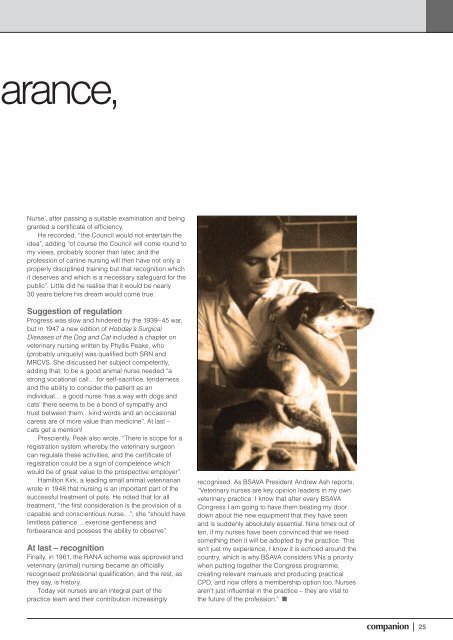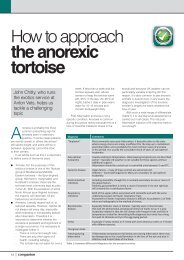Companion May 2012 - BSAVA
Companion May 2012 - BSAVA
Companion May 2012 - BSAVA
You also want an ePaper? Increase the reach of your titles
YUMPU automatically turns print PDFs into web optimized ePapers that Google loves.
ance,<br />
Nurse’, after passing a suitable examination and being<br />
granted a certificate of efficiency.<br />
He recorded, “the Council would not entertain the<br />
idea”, adding “of course the Council will come round to<br />
my views, probably sooner than later; and the<br />
profession of canine nursing will then have not only a<br />
properly disciplined training but that recognition which<br />
it deserves and which is a necessary safeguard for the<br />
public”. Little did he realise that it would be nearly<br />
30 years before his dream would come true.<br />
Suggestion of regulation<br />
Progress was slow and hindered by the 1939–45 war,<br />
but in 1947 a new edition of Hobday’s Surgical<br />
Diseases of the Dog and Cat included a chapter on<br />
veterinary nursing written by Phyllis Peake, who<br />
(probably uniquely) was qualified both SRN and<br />
MRCVS. She discussed her subject competently,<br />
adding that, to be a good animal nurse needed “a<br />
strong vocational call… for self-sacrifice, tenderness<br />
and the ability to consider the patient as an<br />
individual… a good nurse ‘has a way with dogs and<br />
cats’ there seems to be a bond of sympathy and<br />
trust between them…kind words and an occasional<br />
caress are of more value than medicine”. At last –<br />
cats get a mention!<br />
Presciently, Peak also wrote, “There is scope for a<br />
registration system whereby the veterinary surgeon<br />
can regulate these activities, and the certificate of<br />
registration could be a sign of competence which<br />
would be of great value to the prospective employer”.<br />
Hamilton Kirk, a leading small animal veterinarian<br />
wrote in 1948 that nursing is an important part of the<br />
successful treatment of pets. He noted that for all<br />
treatment, “the first consideration is the provision of a<br />
capable and conscientious nurse…”; she “should have<br />
limitless patience… exercise gentleness and<br />
forbearance and possess the ability to observe”.<br />
At last – recognition<br />
Finally, in 1961, the RANA scheme was approved and<br />
veterinary (animal) nursing became an officially<br />
recognised professional qualification, and the rest, as<br />
they say, is history.<br />
Today vet nurses are an integral part of the<br />
practice team and their contribution increasingly<br />
recognised. As <strong>BSAVA</strong> President Andrew Ash reports,<br />
“Veterinary nurses are key opinion leaders in my own<br />
veterinary practice. I know that after every <strong>BSAVA</strong><br />
Congress I am going to have them beating my door<br />
down about the new equipment that they have seen<br />
and is suddenly absolutely essential. Nine times out of<br />
ten, if my nurses have been convinced that we need<br />
something then it will be adopted by the practice. This<br />
isn’t just my experience, I know it is echoed around the<br />
country, which is why <strong>BSAVA</strong> considers VNs a priority<br />
when putting together the Congress programme,<br />
creating relevant manuals and producing practical<br />
CPD, and now offers a membership option too. Nurses<br />
aren’t just influential in the practice – they are vital to<br />
the future of the profession.” ■<br />
companion | 25



